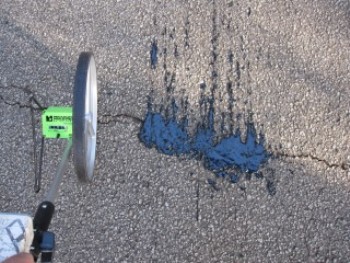Georgia Tech Research Institute (GTRI) has designed a prototype automated pavement crack detection and sealing system to prevent workers from getting exposed to hazardous traffic.
 Example of a pavement crack filled with the prototype automated pavement crack detection and sealing system developed at the Georgia Tech Research Institute
Example of a pavement crack filled with the prototype automated pavement crack detection and sealing system developed at the Georgia Tech Research Institute
Moreover, standard manual crack sealing operations cover only a limited amount of roadway per day. The cracks are sealed in roadways to maintain the structural integrity of the road and prolong the time between the repaving projects.
During the road test, the new system detected the cracks lesser than one-eighth-inch wide and filled the cracks from a vehicle moving at speed of 3 miles per hour.
Jonathan Holmes, Research Engineer at GTRI, stated that the prototype system has demonstrated that an automated crack sealing system at the commercial scale is viable. He added that they have also developed solutions for technical challenges that include high-speed firing of nozzles, limited-scale system and automated crack detection and navigation in real-time.
The automated crack sealing system ensures safety of the workers, increases the amount of roadway covered each day, requires less number of personnel, and also saves transportation cost for the departments since sealing of cracks prolongs the time before the roadway is completely repaved.
The prototype system comprises two different colors of light emitting diodes (LEDs), a stereo camera, and an assembly to supply sealant to transverse and longitudinal sealant distribution systems continuously. The LEDs illuminated the road in two different directions that are perpendicular and parallel to the road while the system traveled along a road lane. The stereo camera captured two images of the road simultaneously. The images were analyzed using thresholding and filtering algorithms. Based on the image, a crack map was generated to define the location and shape of the cracks. A dispensing nozzle was fixed to a linear servo axis to fill the longitudinal cracks.
Holmes stated that they had only limited crack detection algorithm since they utilized a vision-based system. A full-scale system would need a combination of multiple imaging sensors like 3-D laser scanning system. He also proposed that changes will need to be done regarding the way the sealant was supplied to the transverse and longitudinal distribution systems before a full-scale system is realized.